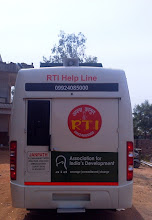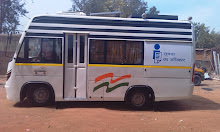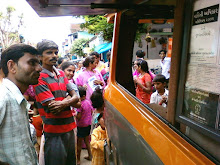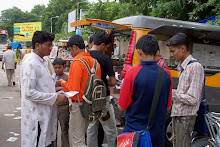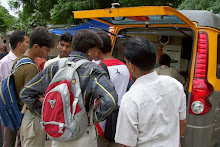Mumbai Mirror: Mumbai: Sunday, June 24, 2018.
Last week, a
group of about 80 people gathered at a midtown event space in Mumbai for the
launch of Aruna Roy’s book, The RTI Story. While the book looks back at the
movement led by Mazdoor Kisan Shakti Sangathan that led to the passing of the
RTI Act in 2005, uppermost on the minds of many RTI users in attendance were
recent attempts to malign those who file applications Once the floor was thrown
open for questions, a member of the audience stood up and asked Roy what RTI
users could do about recent assertions that most of them are blackmailers.
“Even the BMC
commissioner said it,” the man said, referring to statements that reportedly
emanated the upper echelons of the BMC administration in January following the
Kamala Mills fire. Senior BMC officials reportedly said that some RTI activists
indulged in blackmail and extortion. In addition, the BMC even blacklisted
Praja, an NGO that focuses on good governance, for releasing information
acquired under the RTI Act, claiming that the information had been
misrepresented.
Roy’s answer
was simple: “Ask them for the data. Ask them for a list of names and FIRs. They
won’t be able to give it because it is not true.”
What the
blackmail claims are actually about, say RTI users and civil activists, is
discrediting those who use RTI, which in turn is part of a larger campaign to
undermine the act. “It is a formula to call RTI users blackmailers,” says
Krishna Gupta, who, at 20, is one of the country’s youngest RTI activists.
“This is a tactic to scare people.”
Thirteen
years after the landmark RTI Act was passed an Act that is hailed as one of
the best laws anywhere in the world it has proved to be extraordinarily
impactful. Just this week, news broke that Rs 745.59 crore worth of banned
notes were deposited with the Ahmedabad District Co-operative Bank in the first
five days after Prime Minister Narendra Modi announced demonetisation on
November 8, 2016. This was the largest amount collected by any district
co-operative bank, but what made the news particularly noteworthy was that BJP
president Amit Shah is one of the bank’s directors. The source of information
was an RTI application filed by Manoranjan Roy, a Mumbai RTI activist.
Quite
naturally, the resistance to its provisions from those in authority is growing.
In Maharashtra alone, there were over 41,000 RTI appeals pending as of October
2017, according to a report by the New Delhi-based Satark Nagrik Sangathan and
Centre for Equity Studies. The state also left the post of its chief
information commissioner vacant between May last year and June this year,
before appointing former a former state chief secretary. A study by Moneylife
Foundation, an NGO that engages in advocacy and works on improving financial
literacy, states that 90 per cent of information commissioners are civil
servants, despite the Supreme Court saying back in 2013 that governments must
also look outside the bureaucracy for candidates. Meanwhile, the central
government wants to downgrade the standing of an information commissioner from
that of a judge to a secretary, and is also considering amendments to the Act.
More chillingly, there have reportedly been over 300 attacks against RTI users,
including 51 murders. Maharashtra is the most unsafe state for RTI users, with
10 deaths and two suicides.
But across
India, and especially in Mumbai, citizens are fighting back, and Shailesh
Gandhi, a former central information commissioner who was also part of the
campaign to enact the law, is at the forefront of the resistance. He holds
workshops on the Act for citizens and government agencies, and organises
campaigns in defence of it. After Mehta’s reported comments, he sent a letter
to the BMC commissioner stating, “For too long have RTI users and activists
tolerated the arrogance, pompousness and illegal actions of public servants who
wish to continue as kings and courtiers. You and BMC are consistently insulting
citizens and trying to besmirch a right, which exposes the Municipal
Corporation and its misdeeds.”
According to
Gandhi, the Act is being besieged on three sides. The first is that Public
Information Officers (PIOs) have devised strategies of how not to give
information, the second is the classification of RTI users as blackmailers and
extortionists, and the third is recent rulings passed by the courts. “A lot of
their interpretations are slowly strangling the law,” Gandhi told Mumbai Mirror
in an interview. One such judgment Gandhi refers to is in the Girish
Ramachandra Deshpande case, in which the Supreme Court denied the release of
information relating to the salary of a government official, memos relating to
his censure, details of gifts received and asset and investment information, on
the grounds that it was personal information and, therefore, would amount to
invasion of privacy. According to Professor Sridhar Acharyulu, a sitting central
information commissioner, about 60 per cent of RTI applications are being
rejected citing this order as precedent.
Gandhi calls
the reports of blackmail an out and out lie. He says of the over 20,000 appeals
he has dealt with, there was a problem with “about five percent of them”. In
order to combat such accusations, he hit upon an idea of getting government
bodies to upload RTI applications and their replies on their respective
websites. When Gandhi came across a video of a speech made in the House by Navi
Mumbai corporator Krishna Patkar, in which he accused RTI users of being
extortionists, he called up Patkar, introduced himself and proposed his idea.
He explained that a DoPT circular and a Maharahstra government circular stating
the same idea already existed. According to Gandhi, Patkar agreed to formally
propose it. “If the information is on the website, how will anyone blackmail?”
says Gandhi.
In order to
be more effective and to get numbers, he drafted other RTI users, who were also
concerned by the growing antagonism towards them. Among them were Gupta, who
gives lectures at colleges advising students on how to file RTI applications
and on what issues to pursue; Sunil Ahya, a former electronic goods
manufacturer turned lawyer who has been using RTI for a decade; and Naveen
Saraf, a chartered accountant, who only began using RTI six months ago.
Together, they convinced the corporations of Navi Mumbai, Mira-Bhayander,
Nashik, Yavatmal and a handful of others. Initially, the BMC was not one of
them but on May 4, corporator Alka Ketkar put forth the point of motion in the
house and the resolution was approved. Of course, that’s only the first step.
“The next challenge is getting it implemented and the third challenge, which is
even bigger, is getting it sustained,” says Gandhi.
Sucheta
Dalal, one of the co-founders of Moneylife, set up an RTI centre last year,
thanks to funding the foundation received from whistleblower Dinesh Thakur, who
exposed the data manipulation taking place at drugs manufacturer Ranbaxy. Along
with Gandhi, her foundation is working on creating a database of decisions and
figuring out how government bodies should upload their RTI data. “If all the
information is not put out in a searchable manner, with headnotes and an index,
it is of no use to anyone,” she says.
Gandhi has
already begun collating a set of “positive decisions” from RTI commissioners
that future applicants can use in their own cases, should they go to appeal.
The idea is to create a bank of precedents so that applicants are better able
to argue their side, especially in front of commissioners who might be
sympathetic towards the government.
Gandhi is
also critical of the time it takes for commissioners to handle appeals. While
the law mandates 30 days for Public Information Officers to respond and 30 to
45 days for first appeals to be heard, there is no time limit for second
appeals before a commissioner. “There is no accountability for the
Commissioners but there is a moral responsibility,” says Gandhi.
Every year 40
to 60 lakh RTI applications are filed in India but this is still a tiny
fraction relative to India’s population. In order to increase RTI’s reach,
seminars and workshops are being held across the country. There are websites,
such as RTIIndia.org that provide help to anyone who wants to file an RTI
application (Ahya learned about RTI from the website and today routinely
answers questioned posed by others as a way of paying it back). In Mumbai,
various orgnisations hold workshops, such as Moneylife Foundation and Mahiti
Adhikar Manch, an RTI focused-NGO.
Every
Wednesday evening for two hours, Gandhi holds a seminar at the Moneylife
Foundation in Dadar, where he explains the Act and provides assistance to
anyone who wants to file RTI applications.
At a recent
seminar, Gandhi exhorted a group of law students interning at the Public
Concern for Governance Trust to “avoid question marks” in their applications
because “it will get all tangled up and will take a year.” The students were
mostly interested in water and sanitation issues and Gandhi counselled them to
narrow the focus of their application so the PIOs can’t claim that they are
asking for too much information. “Don’t ask how many inspections were carried
out. Ask for all the inspection reports for the last two years,” Gandhi said.
“Ask for the minimum amount of information but it should be like an arrow.”
Saraf, the
chartered accountant, has attended Gandhi’s seminars at the Moneylife
foundation, and believes there should be many more of them so that people start
to use RTI in their daily lives, such as when applying for a ration card. “If
more people used it, then the government would not be able to undermine it
because they would lose their vote bank,” he says.
Another tool
contained in the pages of the RTI Act, but rarely used, is the right to
inspection. It is a tool that Gupta used to inspect the Temba Hospital (a
government hospital) in Bhayander because he was worried about the level of
care that was available. First, he asked for a list of machinery present at or
allotted to, the hospital. Once he got the list, he filed a second RTI asking
to inspect the hospital under Section 2 (j) of the RTI Act. Armed with the
list, Gupta can be seen alongside hospital staff opening boxes and checking
their contents in a video of the inspection that was uploaded to YouTube. “We
found that either the machines were not working or they were still packed. Very
few machines were working,” Gupta says.
Similarly,
Bhaskar Prabhu, the convenor of Mahiti Adhikar Manch, which networks with
public authorities and runs open houses on how to file RTI applications every
week at St. Joseph’s School in Wadala, encourages the use of the inspection
clause. “People talk about [inspecting] big bridges. You need not do that. Just
do a small ground or a pavement, or whether the storm water drain near you is
cleaned or not,” Prabhu says. He claims if citizens do this, they will be able
to reduce public spending by 20 to 30 per cent.
There is an
inherent tension between the purpose of the Act, which is to disclose
information, and authorities, who prefer to conceal it. At an event on the RTI
organised by Moneylife Foundation last month, which was attended by over 100
people, former Maharahstra chief minister Prithiviraj Chavan said, to much
laughter, that when he was in the DoPT, he was responsible for the legislation,
but “when I came to Mumbai (as CM), I was on the other side and then I wanted
to hide information from coming out.”
This tension
creates a gulf between user and official, says Ahya. “Between government and
the public, there is apprehension on both sides. Citizens think the government
is not doing the right thing and the government thinks the citizen is not
genuine.” However, if this attitude were to change, Ahya says, then it would be
a better experience for everyone and users would be more likely to get the
information they want. According to him, he has never had an unpleasant RTI
experience for that reason. “If people explain things, then you can convince
the other person,” he says. “It should not be personal.”
It is an
approach that Prabhu endorses. “RTI is about bringing in good governance. It
cannot be working against the government,” he says. In other words, there is
more to the RTI than exposing corruption. It can improve efficiency and the
responsiveness of government, providing it is used in that way. “Then the
public authority will understand what is the need for the people,” Prabhu says.
No matter the
party or parties in power, governments have tried to dilute the RTI act ever
since it was passed. The first attempt at amending the Act was made about eight
months after it came into law by the same government that passed it. That
attempt was defeated by public protest and Roy believes the same approach will
be required to stop the current government from amending the act too. “We will
have to go to the streets. It is a war of attrition. We can’t give up.”













